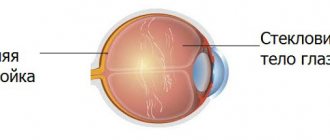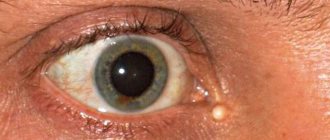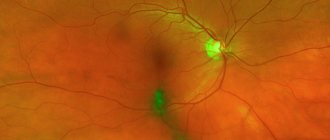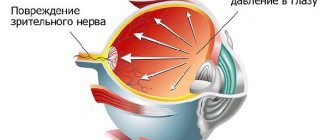Fog in the eyes or blurred vision is one of the most common complaints of patients with eye pathologies. The symptom is manifested by a change in visual acuity, when the ability to clearly distinguish small details disappears when looking into the distance or when visually working at close range. At the same time, a decrease in visual acuity or its sharpness occurs over some time - gradually.
This is the most important sign of eye diseases, which can appear in one eye, then they speak of unilateral blurring, or in both eyes - bilateral (general) blurred vision.
In cases where critical visual impairment or the onset of complete blindness occurs suddenly, we are talking about a symptom of vision loss.
Causes of blurred vision
The causes of blurred vision may be toxicosis of pregnant women and other intoxications, including nicotine, ethyl or methyl alcohol, quinine, lead and some other active substances. Such poisonings can lead to complete loss of visual function.
Sometimes the cause of blurred vision is vasospasm of the blood vessels of the eye, in particular the retina. This is a functional disorder that does not lead to organic damage to blood vessels, but is accompanied by impaired blood flow. People with hypertension, migraines, and chronic stress are susceptible to vascular spasms. Spasms can also occur during pregnancy (with severe toxicosis and the development of eclampsia) or poisoning. In addition to blurred vision, such patients often develop black spots and spots before their eyes, and their overall visual acuity often decreases. Symptoms of vasospasm last from several minutes to several hours. If the doctor suspects such a condition in a patient, an ophthalmoscopy should be performed. At the same time, it is not possible to detect structural changes in the fundus of the eye, however, in the presence of atherosclerosis, the doctor diagnoses sclerotic lesions of the vessels of the fundus.
The most common cause of blurred vision is glaucoma. In this case, an increase in intraocular pressure occurs, which may be primary in nature or result from injury or other changes in the structures of the eye. Against this background, overall visual acuity decreases and a veil appears before the eyes. In addition to these signs, increased intraocular pressure is characterized by the presence of pain in the temples, eyes, and head. Rainbow circles or halos around point light sources are also added.
When examining a patient with glaucoma, the doctor may detect signs of corneal edema and a decrease in the depth of the anterior chamber of the eye. With an advanced pathological process, there is pallor of the optic nerve head and its excavation.
Additionally, blurred vision is one of the signs of cataracts. In this case, the cause of this symptom is a decrease in the transparency of the lens lens, and sometimes the vitreous body.
Inflammation and uveitis can also cause blurred vision. The inflammation itself is sluggish and manifests itself only as a gradual decrease in vision and the appearance of floating spots. However, with an exacerbation of the inflammatory process, photophobia, pain, and redness occur. These symptoms are characteristic of iritis and iridocyclitis. Signs of anterior uveitis include blood flow to the perilimbal space, as well as narrowing of the pupillary opening.
Treatment for blurred vision in one eye
To treat blurred vision, it is necessary to examine the structure of the eye and determine what is causing the symptom.
Typically, when it comes to vision problems, the cause is usually a refractive error, which can be corrected by wearing glasses, contact lenses or through refractive surgery.
In the case of cataracts, the ideal treatment is to undergo cataract surgery to remove the opaque lens and replace it with a intraocular lens .
During cataract surgery, you may also correct some refractive error that the patient has.
Diagnostics
To conduct a diagnostic examination in patients with similar symptoms, it is necessary to perform biomicroscopy with a slit lamp. In this case, inflammatory hyperemia can be detected in the endothelium.
With intermediate uveitis, inflammatory cells are found already in the vitreous substance, as well as aggregates in its lower and anterior regions. Also, with uveitis, there are signs of an exudative process, which leads to the appearance of membranes lining the lower part of the ciliary body. It is quite easy for a doctor to visualize cells and inflammatory aggregates in the vitreous substance, but only an experienced specialist can see the membranes of the ciliary body.
In the case of posterior uveitis, the main signs of pathology are strands or individual cells in the vitreous substance. Sometimes areas of damage to the fundus and inflammatory reactions in the choroid are detected.
The consequences of uveitis can be the most threatening, therefore, if such signs are detected in a patient, treatment should be prescribed as soon as possible.
Treatment for foggy eyes
It is possible to get rid of fog in the eyes only by curing the cause that caused this symptom. At the Eye Clinic on Kurzenkova you can undergo a comprehensive examination of the visual system, which will identify the factors that served as the impetus for the occurrence of an unpleasant symptom. Our specialists are ready to help patients treat even very complex eye diseases. For this purpose, the Vision Correction Center has assembled the latest equipment for the diagnosis, therapy and surgery of eye pathologies.
We provide any ophthalmological services, from the selection of glasses and contact lenses, to complex microsurgical operations on the posterior and anterior segments of the eye.
Therefore, if even slight blurred vision appears, do not ignore this symptom. Be sure to make an appointment with an ophthalmologist, because the sooner a diagnosis is made, the faster you can get rid of the problem without aggravating it or starting it.
Treatment
Treatment tactics for blurred vision entirely depend on the cause of this condition. Often, patients with such symptoms are urgently hospitalized in a specialized clinic for surgery. This situation is typical for an acute attack of glaucoma, which cannot be stopped by other methods. In this regard, patients who have a veil before their eyes should urgently visit an ophthalmologist.
When choosing a clinic to which you can entrust your vision, you should pay attention to centers equipped with modern diagnostic equipment. This will allow you to quickly and more accurately determine the cause of vision pathology and save you from wasting time in queues. The list of ophthalmological centers presented below will help you make your choice as soon as possible.
What is blurred vision?
Blurred vision is a symptom that prevents images from coming into correct focus at short or long distances, making it difficult to see colors and distances between objects clearly.
This change consists of a loss of visual acuity , very often after you have spent a lot of time looking at digital screens.
Interestingly, overexposure to digital screens such as a computer, mobile phone, TV or any other electronic device can lead to ocular fatigue or precipitate the presence of tired vision.
As a summary, it can be said that blurred vision is a symptom that is associated with many pathologies and that it is not necessarily related to a disease or ocular structure .
Recommended clinics for cataract treatment
“Dr. Shilova’s Eye Clinic” is one of the leading ophthalmological centers in Moscow, where all modern methods of surgical treatment of cataracts are available. The latest equipment and recognized specialists are a guarantee of high results. Go to the organization's page in the directory {amp}gt;{amp}gt;{amp}gt;
“MNTK named after Svyatoslav Fedorov” is a large ophthalmological complex “Eye Mycosurgery” with 10 branches in various cities of the Russian Federation, founded by Svyatoslav Nikolaevich Fedorov. Over the years of its work, more than 5 million people have received assistance. Go to the organization's page in the directory {amp}gt;{amp}gt;{amp}gt;
“Helmholtz Institute of Eye Diseases” is the oldest research and medical state institution for ophthalmology. It employs more than 600 people who provide care to people with a wide range of diseases. Go to the organization's page in the directory {amp}gt;{amp}gt;{amp}gt;
Recommended clinics for cataract treatment
“Dr. Shilova’s Eye Clinic” is one of the leading ophthalmological centers in Moscow, where all modern methods of surgical treatment of cataracts are available. The latest equipment and recognized specialists are a guarantee of high results. Go to the organization's page in the directory {amp}gt;{amp}gt;{amp}gt;
“MNTK named after Svyatoslav Fedorov” is a large ophthalmological complex “Eye Mycosurgery” with 10 branches in various cities of the Russian Federation, founded by Svyatoslav Nikolaevich Fedorov. Over the years of its work, more than 5 million people have received assistance. Go to the organization's page in the directory {amp}gt;{amp}gt;{amp}gt;
“Helmholtz Institute of Eye Diseases” is the oldest research and medical state institution for ophthalmology. It employs more than 600 people who provide care to people with a wide range of diseases. Go to the organization's page in the directory {amp}gt;{amp}gt;{amp}gt;
Preventing blurred vision
The following diseases and conditions are usually the causes that can cause blurred vision:
- Glaucoma, with increased intraocular pressure.
- Cataract, with clouding of the lens.
- Opacities in the vitreous body.
- Retinal vasospasm.
- Bleeding in the eye.
- Uveitis, with inflammatory damage to the choroid and the gradual development of a similar condition.
- Raynaud's disease, when all the vessels of the body are in a spastic state.
- Pregnancy pathologies (preeclampsia, eclampsia).
- Arterial hypertension.
- Migraine, if attacks occur frequently enough.
It should be noted that blurred vision can be observed in one eye or in both eyes at once (unilateral and bilateral). In the first case, we can talk about purely ocular pathologies (pathologies of the optic nerve, spasm in the retinal arteries, glaucoma, cataracts, etc.). With cataracts, for example, blurred vision is explained by clouding of the lens; it occurs gradually and only in the affected eye.
To prevent such an unpleasant condition as blurred vision, the following measures must be taken: regularly visit an ophthalmologist; control blood sugar and cholesterol levels; measure blood pressure; eliminate psycho-emotional stress and stress.
In conclusion, I would like to note that if blurred vision occurs (sudden or developing gradually), it is imperative to consult a doctor. In some situations, this will help save lives; in less dangerous situations, it will help prevent loss of vision and avoid complications. At the same time, it is worth remembering that treatment should not aim at eliminating this symptom, but at eradicating the pathological process itself that led to blurred vision.
Diseases
Foggy eyes can appear in a person for various reasons, including:
- Refractive errors.
- Development of cataracts. Most often observed in patients over 60 years of age. It can be observed in one eye or both.
- Retinal lesions, including uveitis, chorioretinitis, retinopathy.
- Pathologies of the optic nerve. In such cases, patients may experience pain in addition to the fog in their eyes.
- Opacities of the cornea. They can develop both due to previous diseases and as a result of thermal or chemical burns of the mucous membrane, as well as degenerative processes.
- Inflammatory eye diseases, including conjunctivitis, keratitis, iridocyclitis. In such cases, clouding is accompanied by mucosal hyperemia, photophobia, and increased lacrimation.
- Taking some drops that break up the tear film. Foggy eyes may persist for several days after such remedies.
- Pathologies of the heart and blood vessels.
- Kidney diseases.
- Blood loss, including that caused by severe penetrating wounds.
- Angiospasms. Observed as a result of oxygen starvation of the eyeball.
- Glaucoma.
- Various types of anemia.
- Hypertonic disease.
In rare cases, cloudy vision can be caused by serious illnesses, including malignant tumors in the brain.
Among the most frequently diagnosed diseases that provoke such symptoms are:
- cataracts or swelling of the cornea. In addition to blurred vision, the patient experiences pain, complains of intolerance to bright light, and the shade of the cornea changes;
- secondary cataract. Appears upon completion of surgical intervention for an illness, indicates clouding in the lens bag;
- ailments of the optic nerve (atrophy, deformation, etc.). The clinical picture is complemented by a malfunction in the process of color perception, disturbances in visual fields;
- glaucoma. The patient has “pounding in the ears” and a severe headache;
- hemorrhage in the optic nerve;
- inflammatory processes accompanied by pain and burning in the eyes;
- myopia, farsightedness;
- pathologies of the retina (uveitis, retinopathy, etc.). The patient sees poorly, the latter has “lightning in his eyes”, there is no painful sensation;
- iridocyclitis. Fog is visible only in one of the eyes. The patient complains of photophobia, lacrimation, pain, and the color and pattern of the iris changes.
In addition to eye pathologies, other pathologies can be identified during the diagnostic process: hypertension, anemia, diabetes mellitus, sexually transmitted diseases, central nervous system lesions, brain injuries, etc.
The appearance of fog before the eyes is a completely understandable phenomenon and can be triggered by the following factors:
- Clouding of the cornea of the eye. The pathology is caused by inflammatory diseases of the eye, injuries, burns, dystrophy.
- Cataract. This phenomenon is called cataracts and in most cases is explained by age-related changes in the substance of the eye lens. Cataracts are a particularly common cause of blurred vision in people over 50–60 years of age.
- Retinal disease. Blurred vision can be caused by diabetic and hypertensive retinopathy, chorioretinitis, uveitis, and macular degeneration.
- Pathologies of the optic nerve. Inflammation of the optic nerve at the initial stage is accompanied by a feeling of blurriness of visible objects; this fog is the first symptom of the disease. Then pain occurs when moving the eye.
- Refractive errors. Myopia, farsightedness, and astigmatism are the most common causes of foggy eyes. To eliminate this symptom, correct vision correction with glasses or contact lenses is necessary. Sometimes blurred vision is possible when wearing contact lenses. In this case, you need to consult an ophthalmologist to rule out possible inflammation of the cornea.
- Computer vision syndrome. Working at a computer for a long time and the resulting visual fatigue is often accompanied by complaints of fog in the eyes. This is explained by a spasm of the image-focusing muscle. After sufficient rest, vision is usually restored.
- Instillation of eye drops. Some eye drops cause temporary blurred vision, which is always indicated in the instructions for the drug.
- Secondary cataract. Some time after cataract surgery, a whitish fog may appear in front of the operated eye. It indicates clouding of the lens capsule and is easily removed by laser dissection.
Symptom Definition
Fog in the eyes is an ophthalmological symptom in which there is a decrease in the clarity of vision.
Patients who complain of such an anomaly lose the opportunity to examine small details up close or at a long distance. The symptom may gradually progress, leading to complete or partial loss of vision. As the provoking disease develops, in addition to the main symptom, the patient may experience pain in the eye, lacrimation, tissue swelling, loss of the visual field and a number of other signs associated with a specific pathology.










